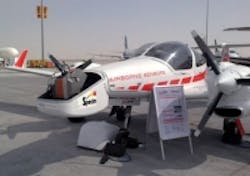Collaboration produces hyperspectral multi-sensor aircraft
A partnership between Diamond Aircraft, SPECIM, and Exogenesis has resulted in the first commercially available hyperspectral multi-sensor aircraft, which is capable of imaging targets in the 380 to 2,500 nm spectral region.
In the project, SPECIM’s AisaFENIX full spectrum imager was integrated onto a DA42 MPP special mission airplane from Diamond Aircraft. The AisaFENIX imager is a compact hyperspectral camera that captures data over visible and near infrared (VNIR), near-infrared (NIR), and shortwave infrared (SWIR) wavelengths for field and airborne installation. The camera features two focal plane arrays: One CMOS and one mercury cadmium telluride (MCT). The CMOS detector, which images in the VNIR range and has a 12-bit Camera Link output, features a spectral range of 380-970 nm and a 3.5 nm spectral resolution. The Stirling-cooled MCT detector, which images in the SIWR range and has a 16-bit Camera Link output, features a spectral range of 970 – 2,500 nm and a 12 nm spectral resolution.
The three organizations teamed up to unite hyperspectral data collection and multi-purpose data analysis on the DA42 MPP remote sensing aircraft. Test flights were carried out in Wiener Neustadt, Austria, where Diamond Aircraft is based. In the tests, the AisaFENIX sensor was able to detect all of its intended targets, including potential unexploded weapons and even a body of forest with strong soil-pollution related stress. The hyperspectral sensor was able to detect sub-pixel targets that were less than 3-9& of a size of a single pixel, according to the press release.
Exogenesis was the independent evaluator of the initial integration demonstration. Additionally, Exogenesis developed automated software to process and analyze the hyperspectral data collected by the AISA FENIX and to integrate and fuse it with LIDAR and ortho photo sensors.
During the tests—which yielded zero false positives—a gyro-stabilized mounting from SOMAG was used for the AisaFENIX sensor as well as the system’s navigation and geo-referencing systems. The DA42 MPP Geostar Hyperspectral is particularly suited for intelligence, surveillance, and reconnaissance (ISR), mineralogy, or environmental applications, and is now available as a commercial product.
View the press release.
View more information on the AisaFENIX sensor.
Also check out:
FAA approves flight of first commercial UAV
Headwall Photonics releases airborne sensor and image acquisition solution
Airborne image sensor capable of detecting dangerous substances and gases
Share your vision-related news by contacting James Carroll, Senior Web Editor, Vision Systems Design
To receive news like this in your inbox, click here.
Join our LinkedIn group | Like us on Facebook | Follow us on Twitter | Check us out on Google +
About the Author

James Carroll
Former VSD Editor James Carroll joined the team 2013. Carroll covered machine vision and imaging from numerous angles, including application stories, industry news, market updates, and new products. In addition to writing and editing articles, Carroll managed the Innovators Awards program and webcasts.
